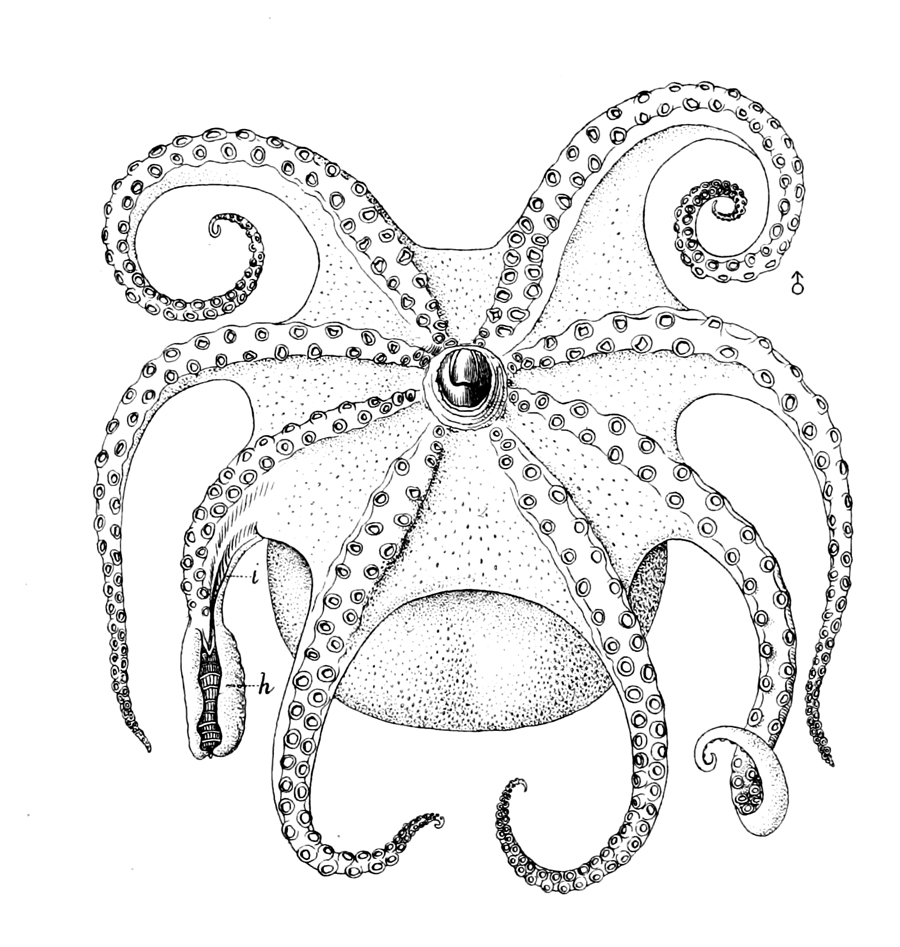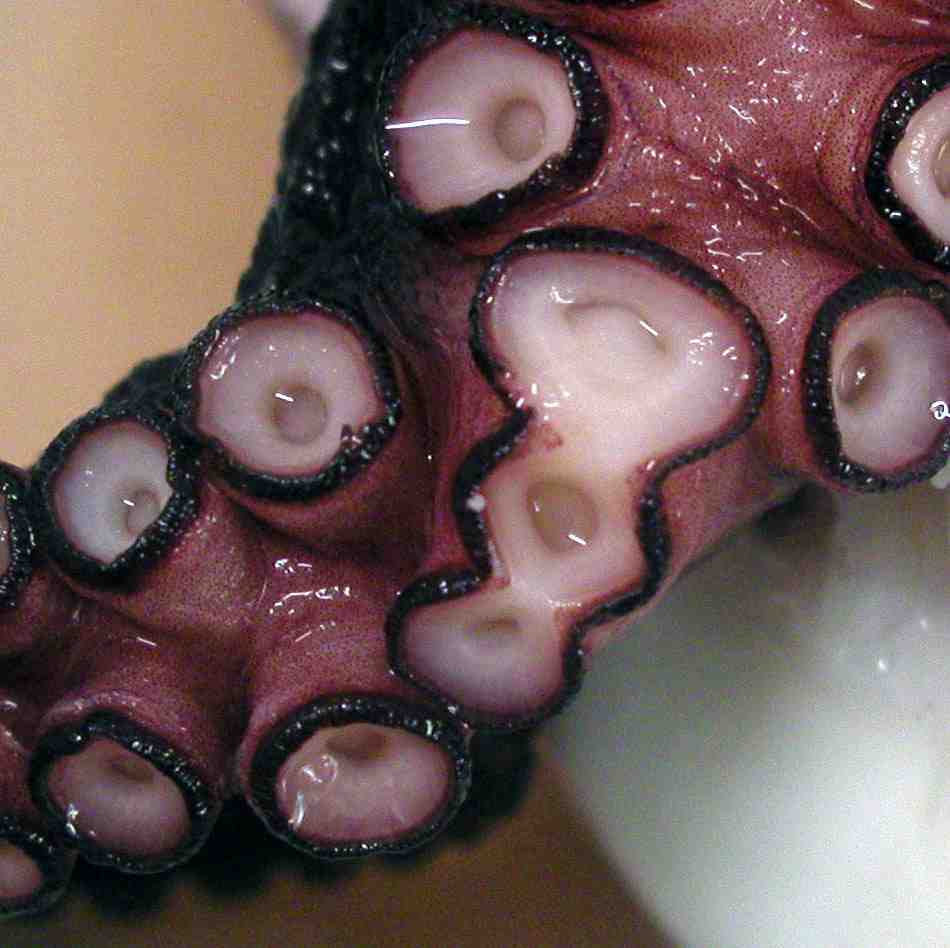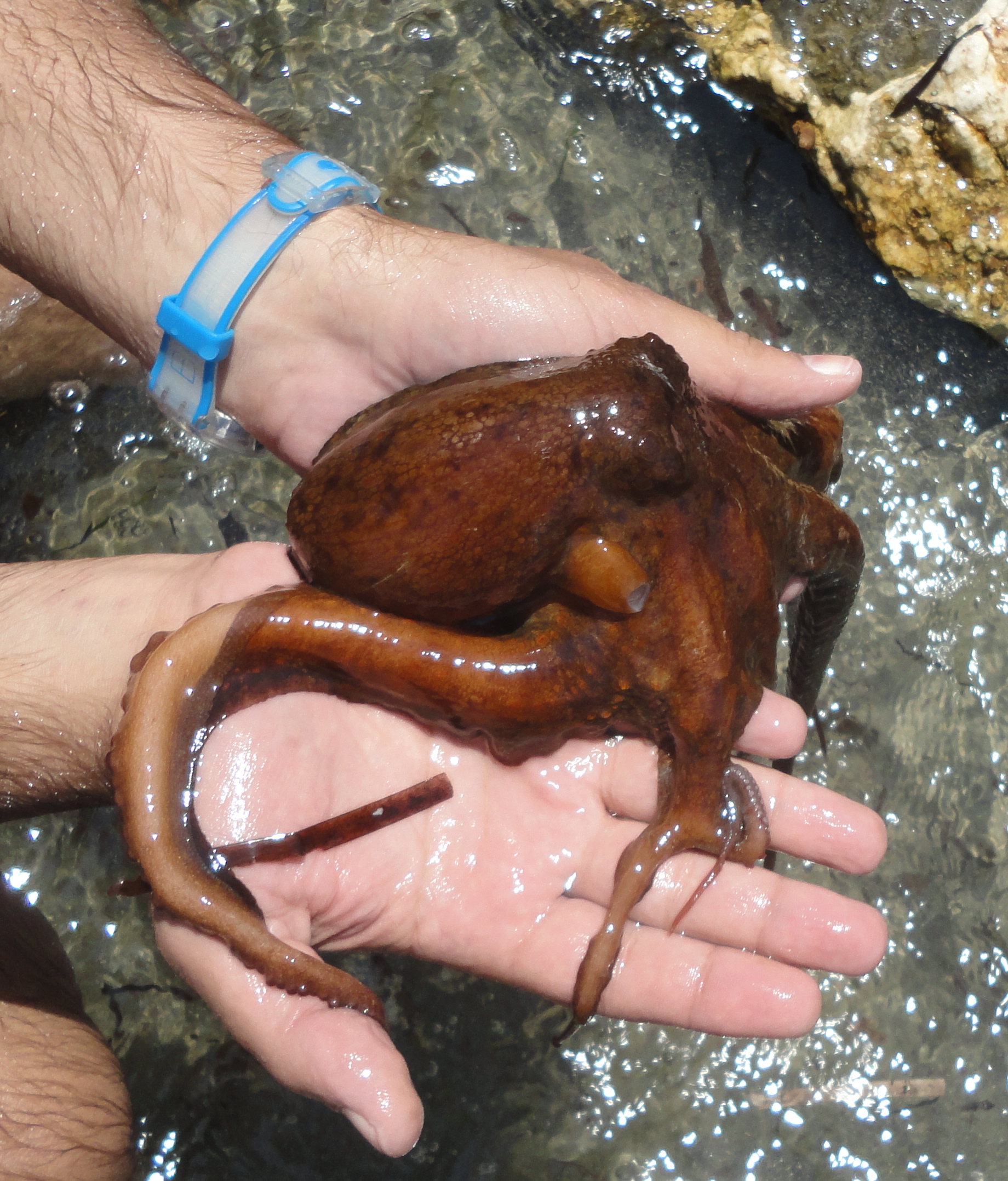Cephalopod Limb on:
[Wikipedia]
[Google]
[Amazon]






 All
All
Cephalopoda Glossary
Tree of Life web project. Barring a few exceptions, octopuses have eight arms and no tentacles, while






 All
All cephalopod
A cephalopod is any member of the molluscan Taxonomic rank, class Cephalopoda (Greek language, Greek plural , ; "head-feet") such as a squid, octopus, cuttlefish, or nautilus. These exclusively marine animals are characterized by bilateral symm ...
s possess flexible limbs extending from their heads and surrounding their beaks. These appendages, which function as muscular hydrostats, have been variously termed arms, legs or tentacles.
Description
In the scientific literature, a cephalopod ''arm'' is often treated as distinct from a '' tentacle'', though the terms are sometimes used interchangeably, often with the latter acting as anumbrella term
Hypernymy and hyponymy are the wikt:Wiktionary:Semantic relations, semantic relations between a generic term (''hypernym'') and a more specific term (''hyponym''). The hypernym is also called a ''supertype'', ''umbrella term'', or ''blanket term ...
for cephalopod limbs. Generally, arms have suckers along most of their length, as opposed to tentacles, which have suckers only near their ends.Young, R.E., M. Vecchione & K.M. Mangold 1999Cephalopoda Glossary
Tree of Life web project. Barring a few exceptions, octopuses have eight arms and no tentacles, while
squid
A squid (: squid) is a mollusc with an elongated soft body, large eyes, eight cephalopod limb, arms, and two tentacles in the orders Myopsida, Oegopsida, and Bathyteuthida (though many other molluscs within the broader Neocoleoidea are also ...
and cuttlefish
Cuttlefish, or cuttles, are Marine (ocean), marine Mollusca, molluscs of the order (biology), suborder Sepiina. They belong to the class (biology), class Cephalopoda which also includes squid, octopuses, and nautiluses. Cuttlefish have a unique ...
have eight arms (or two "legs" and six "arms") and two tentacles.Norman, M. 2000. ''Cephalopods: A World Guide''. ConchBooks, Hackenheim. p. 15. "There is some confusion around the terms ''arms'' versus ''tentacles''. The numerous limbs of nautilus
A nautilus (; ) is any of the various species within the cephalopod family Nautilidae. This is the sole extant family of the superfamily Nautilaceae and the suborder Nautilina.
It comprises nine living species in two genera, the type genus, ty ...
es are called tentacles. The ring of eight limbs around the mouth in cuttlefish, squids and octopuses are called ''arms''. Cuttlefish and squid also have a pair of specialised limbs attached between the bases of the third and fourth arm pairs .. These are known as ''feeding tentacles'' and are used to shoot out and grab prey." The limbs of nautilus
A nautilus (; ) is any of the various species within the cephalopod family Nautilidae. This is the sole extant family of the superfamily Nautilaceae and the suborder Nautilina.
It comprises nine living species in two genera, the type genus, ty ...
es, which number around 90 and lack suckers altogether, are called cirri.
The tentacles of Decapodiformes are thought to be derived from the fourth arm pair of the ancestral coleoid, but the term ''arms IV'' is used to refer to the subsequent, ventral arm pair in modern animals (which is evolutionarily the fifth arm pair).
The males of most cephalopods develop a specialised arm for sperm delivery, the hectocotylus.
Anatomically, cephalopod limbs function using a crosshatch of helical collagen
Collagen () is the main structural protein in the extracellular matrix of the connective tissues of many animals. It is the most abundant protein in mammals, making up 25% to 35% of protein content. Amino acids are bound together to form a trip ...
fibres in opposition to internal muscular hydrostatic pressure.
Suckers
Cephalopod limbs bear numerous suckers along their ventral surface as in octopus,squid
A squid (: squid) is a mollusc with an elongated soft body, large eyes, eight cephalopod limb, arms, and two tentacles in the orders Myopsida, Oegopsida, and Bathyteuthida (though many other molluscs within the broader Neocoleoidea are also ...
and cuttlefish
Cuttlefish, or cuttles, are Marine (ocean), marine Mollusca, molluscs of the order (biology), suborder Sepiina. They belong to the class (biology), class Cephalopoda which also includes squid, octopuses, and nautiluses. Cuttlefish have a unique ...
arms and in clusters at the ends of the tentacles (if present), as in squid and cuttlefish. Each sucker is usually circular and bowl-like and has two distinct parts: an outer shallow cavity called an ''infundibulum'' and a central hollow cavity called an ''acetabulum''. Both of these structures are thick muscles, and are covered with a chitin
Chitin (carbon, C8hydrogen, H13oxygen, O5nitrogen, N)n ( ) is a long-chain polymer of N-Acetylglucosamine, ''N''-acetylglucosamine, an amide derivative of glucose. Chitin is the second most abundant polysaccharide in nature (behind only cell ...
ous cuticle to make a protective surface. Suckers are used for grasping substratum, catching prey and for locomotion. When a sucker attaches itself to an object, the infundibulum mainly provides adhesion while the central acetabulum is free. Sequential muscle contraction of the infundibulum and acetabulum causes attachment and detachment.
Abnormalities
Many octopus arm anomalies have been recorded, including a 6-armed octopus (nicknamed Henry the Hexapus), a 7-armed octopus, a 10-armed '' Octopus briareus'', one with a forked arm tip, octopuses with double or bilateral hectocotylization, and specimens with up to 96 arm branches. Branched arms and other limb abnormalities have also been recorded incuttlefish
Cuttlefish, or cuttles, are Marine (ocean), marine Mollusca, molluscs of the order (biology), suborder Sepiina. They belong to the class (biology), class Cephalopoda which also includes squid, octopuses, and nautiluses. Cuttlefish have a unique ...
, squid
A squid (: squid) is a mollusc with an elongated soft body, large eyes, eight cephalopod limb, arms, and two tentacles in the orders Myopsida, Oegopsida, and Bathyteuthida (though many other molluscs within the broader Neocoleoidea are also ...
, and bobtail squid.
Variability
Cephalopod limbs and the suckers they bear are shaped in many distinctive ways, and vary considerably between species. Some examples are shown below.Arms
For hectocotylized arms see hectocotylus variability.Tentacular clubs
Suckers
References
Notes
Citations
{{Cephalopod anatomy Cephalopod zootomy